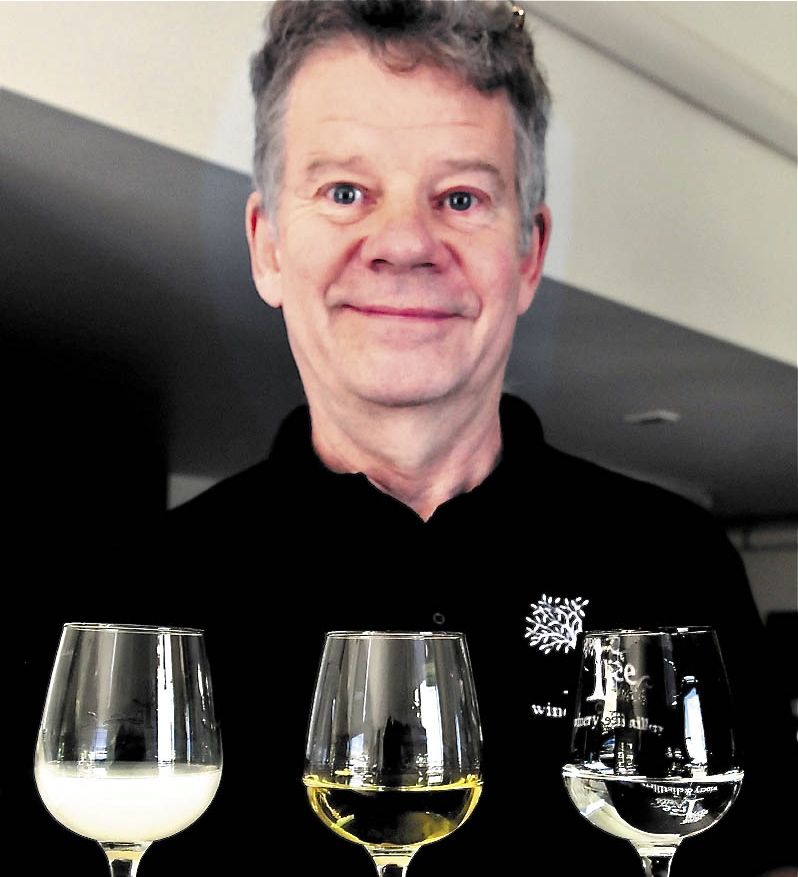OAKLAND — A local company is about to become the first in the state to legally produce and then sell absinthe, a green alcoholic spirit that carries its own air of mystery and subversion.
Absinthe was outlawed in the United States from 1912 to 2007 but can now be legally made and sold under regulation by the federal government. Absinthe is not a hallucinogen, despite legend that it is, according to Bruce Olson, who co-owns Tree Spirits with his partner, Waterville Mayor Karen Heck.
Olson and Heck have created their first gallon or so of absinthe using a traditional recipe from 1800s France and their own apple-based alcohol, in keeping with their trademark of using all locally grown ingredients in their products.
Before the absinthe can be sold, the alcohol and its proposed label have to be approved by the federal Alcohol and Tobacco Tax and Trade Bureau, which holds absinthe to a higher standard than other drinks.
The alcohol itself must not have too much of the chemical thujone, a compound derived from wormwood that has been charged with being psychoactive.
Olson said he doesn’t expect problems with what he considers a rubber-stamp process to appease outdated concerns.
“Traditionally, none of these products are ever over the limit,” he said. “Probably, it’s never been a problem.”
Another test is visual. The product label must not “project images of hallucinogenic, psychotropic, or mind-altering effects,” according to federal guidelines.
Olson’s label features a green fairy — a common symbol and nickname for absinthe — against a black background, but he would not release an image of it for publication until it has been approved.
There are no separate state regulations for making absinthe.
Olson and Heck hope to launch their product from their store after federal approval. They believe they’ll get the OK any time now on thujone levels, and then they plan to immediately mail in their product label, a review that could up to 45 days. The absinthe could start being sold in two months.
Olson, sitting recently behind the bar at Tree Spirits in Oakland, dispensed absinthe in different stages of production. He held it in glass jars of various sizes and shapes as he described how apples and herbs are transformed into what may be the world’s most notorious alcohol.
A jar of raw apple spirit looks and smells like clear rubbing alcohol. But the smell changes significantly after it has been allowed to steep for 24 hours with three plants known among absinthe enthusiasts as the holy trinity — anise, fennel and the infamous wormwood, a much-maligned herb used predominantly in absinthe production.
Once it has been distilled, the liquid is clear again, but the alcohol smell is significantly dampened, almost overtaken by the licorice-like aroma of the anise.
Three more herbs — a different variety of wormwood, lemon balm and hyssop — are added, steeped and then filtered out. The smell, now more complex, is still reminiscent of licorice and the color is changed.
About 20-25 percent of alcohol consumed in Maine is produced in the state, according to Elmer Alcott, an executive with Nappi Distributors.
Both Olson and Alcott said no one else in Maine is authorized to make absinthe for sale. Many stores have sold absinthe in Maine since the U.S. ban was lifted, but the product they sell is made in out of state.
At 120 proof, absinthe is not meant to be drunk straight; instead, it is typically mixed with four parts of water for each part absinthe.
Olson said that not only takes some of the sting out of the cost, but it also capitalizes on a unique characteristic of absinthe — reminiscent of a parlor trick — that helps to set it apart.
When absinthe is ordered in a bar, it is often poured into a glass, which is then topped with a special utensil that spans the top, designed to hold a cube of sugar over the green-tinted liquid below.
As chilled water is poured over the sugar, it dissolves; when the solution mixes with the spirit, the oil content of the herbs becomes de-emulsified, giving the entire concoction a milky-green look.
That transformation is part of what gives absinthe an appeal that has withstood the efforts of government regulators to eliminate it altogether.
Matt Hongoltz-Hetling can be contacted at 861-9287 or at:
mhhetling@centralmaine.com
Send questions/comments to the editors.



Success. Please wait for the page to reload. If the page does not reload within 5 seconds, please refresh the page.
Enter your email and password to access comments.
Hi, to comment on stories you must . This profile is in addition to your subscription and website login.
Already have a commenting profile? .
Invalid username/password.
Please check your email to confirm and complete your registration.
Only subscribers are eligible to post comments. Please subscribe or login first for digital access. Here’s why.
Use the form below to reset your password. When you've submitted your account email, we will send an email with a reset code.